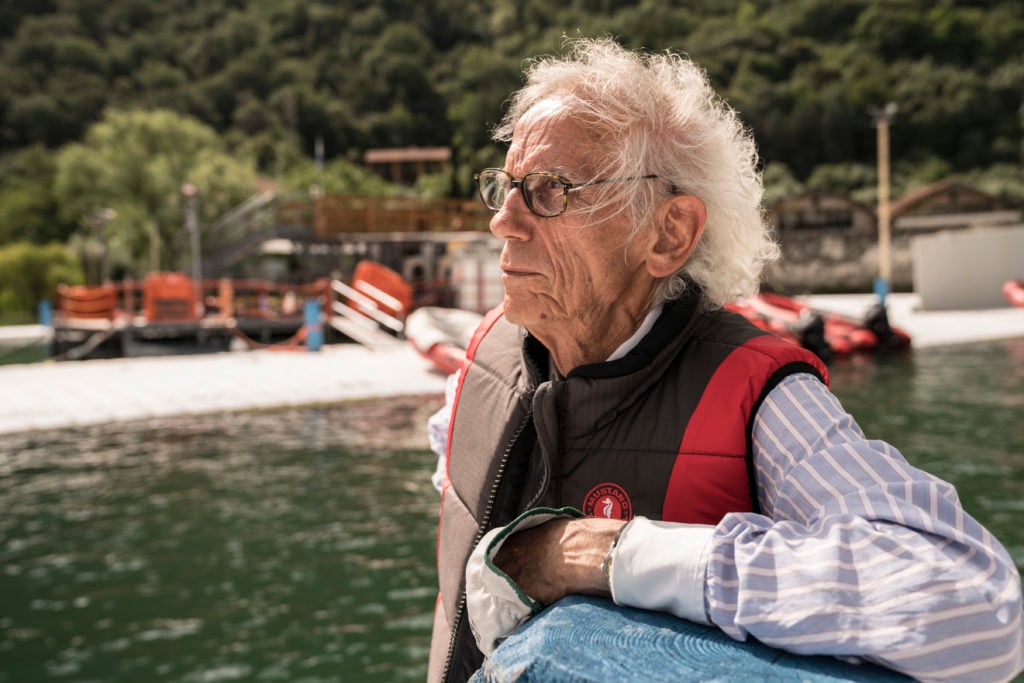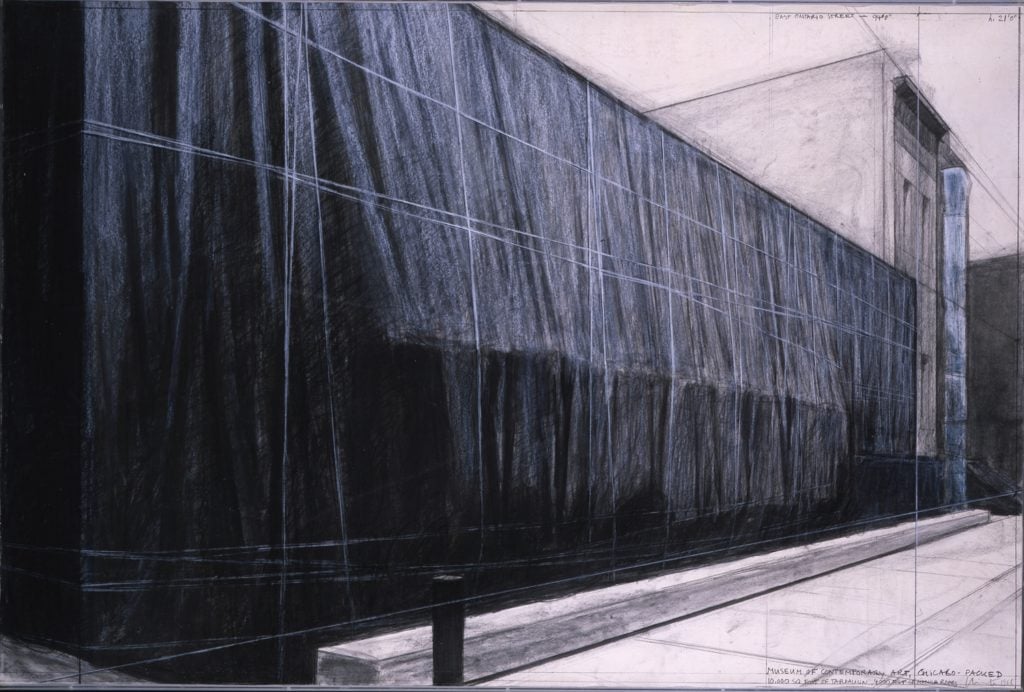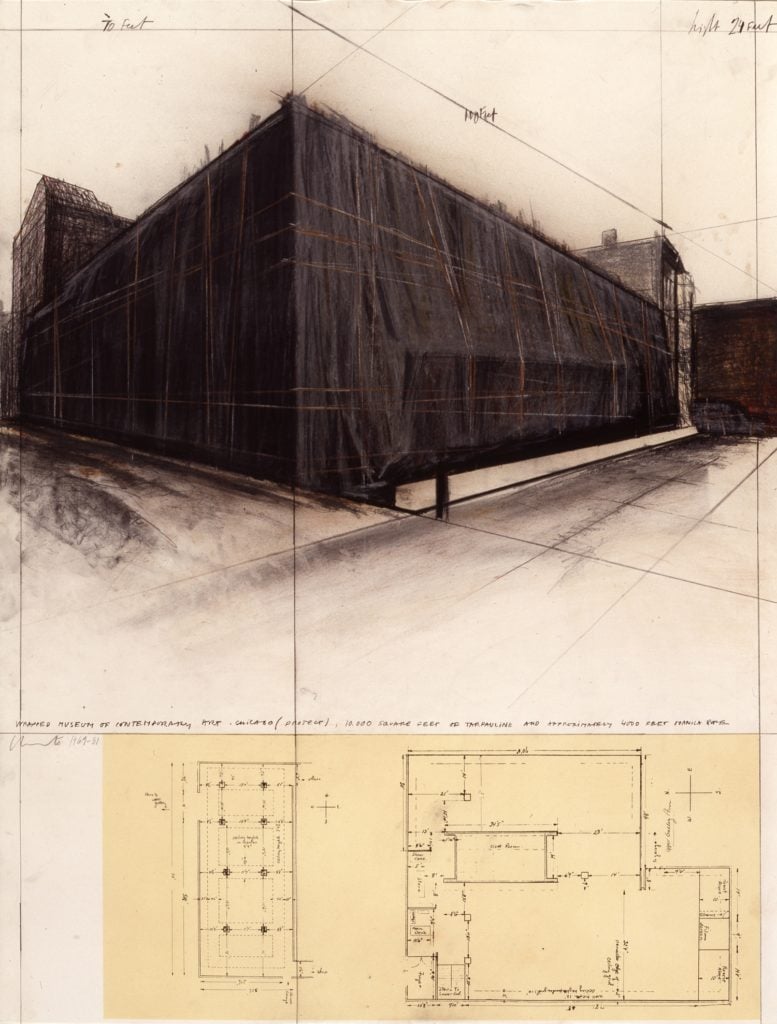Art Fairs
‘American Exceptionalism Is Over’: Christo Reminisces About Being an Undocumented Immigrant in the US
The artist looks back on the time he wrapped Chicago's Museum of Contemporary Art in 1969.

The artist looks back on the time he wrapped Chicago's Museum of Contemporary Art in 1969.

Brian Boucher

Artist duo Christo and Jeanne-Claude wrapped exactly one US building in their entire joint career, and that was the Museum of Contemporary Art Chicago in 1969. Mostly black-and-white renderings of the project, Museum of Contemporary Art—Chicago Packed (Project—20,000 Square Foot), were on view in the US for the first time at the Expo Chicago fair this past weekend, courtesy of Switzerland’s Galerie Gmurzynska.
The fair coincided with the opening of the city’s second architecture biennial, on view through January 7, 2018, which also features numerous instances of interdisciplinary work that moves between art and architecture. Christo and Jeanne-Claude’s project pretty much embodies that kind of ferment, giving Gmurzynska’s display added resonance.

Christo, Museum of Contemporary Art, Chicago (1968). Photo: Andre Grossman, © Christo 1968.
Back in ’69, the Museum of Contemporary Art resided in the former headquarters of Playboy magazine, a structure that Christo likened to a windowless shoebox. So the artists deemed their project, which encased the edifice in some 10,000 square feet of green-brown tarpaulin tied in place with 4,000 feet of rope, to be a distinct improvement. At the same time, to honor the structure’s uniqueness, they opted to encase a column that jutted above the roofline in transparent polyethylene, forming an obelisk set off from the rest.
“It looked fabulous,” said Christo, partly owing to the dark fabric’s contrast with a coating of snow on the ground outside.
The 1969 intervention had a two-part nature: The interior of the museum was also wrapped in fabric, a flourish that the artist described as a “gentle intrusion.” For the indoor installation, the artists wrapped the building’s main staircase and interior floors with the painters’ drop cloths that had been used when workmen painted the galleries.
On the one hand, the space had a reverent atmosphere. “You would take your shoes off, as if you were in a mosque,” Christo said.
On the other, at least some visitors had a more carnal experience. “One day,” he said, “a guard found a young couple making love there.”

Christo, Wrapped Museum of Contemporary Art Chicago (Project) (1969–1981). Photo: Harry Shunk, © Christo 1969–1981.
The 1969 work was unveiled in the cold of a bitter January, but the streets had been on fire during the Chicago riots the previous year, following the assassination of Martin Luther King Jr. The project could thus perhaps be seen as a flamboyantly wrapped gift to a city at a troubled moment.
Today, in another moment of social division, this time centered on anti-immigration sentiment, the project’s return to Chicago also brought to mind the artists’ own status: Christo and Jeanne-Claude came to the US as illegal aliens in 1964.
From his arrival, Christo stayed in the same Lower Manhattan studio where he currently lives today. While he was undocumented, he was paranoid about the police, who regularly parked outside his home. Today, with anti-immigrant sentiment at a fever pitch, he said, he empathized with the similar anxieties faced by the undocumented community.
“But nothing that humans do surprises me anymore,” he added.

Christo, Museum of Contemporary Art Chicago Packed (1968). Photo: Eeva-Inkeri, © Christo 1968.
All the same, the artist didn’t mince words about his view of the current administration, whose anti-immigration policies have led to widespread protest.
“American exceptionalism is over,” he said forcefully. He compared Trump’s presidency to historical dictatorships and isolationist administrations the world over. “This country is now just like Argentina, or Brazil, or Germany.”
(Earlier this year, the artist even pulled out of a long-delayed project in Colorado that was to be sited on government land because it would have required working with the administration.)
But after a moment, Christo waxed more philosophical: “It’s all part of a country becoming mature.”